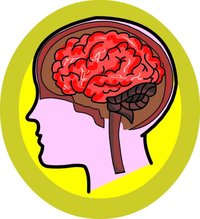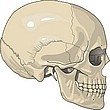Frontal lobe
|
|
| Contents |
Anatomy
In the human brain, the central sulcus separates the frontal lobe from the parietal lobe along the top of each cerebral cortex. The lateral sulcus separates the inferior frontal gyrus of lower frontal lobes from the temporal lobes.
The frontal lobe comprises four major folds of cortical tissue: the precentral gyrus, superior gyrus and the middle gyrus of the frontal gyri, the inferior frontal gyrus.
The precentral gyrus is in front of the central sulcus, and behind the precentral sulcus, which separates it from the frontal gyri. The superior and middle gyri are divided by the superior frontal sulcus. The frontal gyri lie above the inferior frontal gyrus, divided by the inferior frontal sulcus.
Function
In the human brain, the precentral gyrus and the related cortical tissue that folds into the central sulcus comprise the primary motor area, which controls voluntary movements of specific body parts associated with areas of the gyrus.
Frontal lobes have been found to play a part in impulse control, judgement, language, memory, motor function, problem solving, sexual behavior, socialization and spontaneity. Frontal lobes assist in planning, coordinating, controlling and executing behavior. People who have damaged frontal lobes may experience problems with these aspects of cognitive function, being at times impulsive; impaired in their ability to plan and execute complex sequences of actions; perhaps persisting with one course of action or pattern of behaviour when a change would be appropriate (perseveration).
Cognitive maturity associated with adulthood is marked by related maturation of cerebral fibers in the frontal lobes between late teenager years and early adult years. Research by Dr. Arthur Toga, UCLA, found increased myelin in the frontal lobe gray matter of young adults compared to that of teens, whereas, gray matter in parietal and temporal lobes was more fully matured by teen years. Typical onset of schizophrenia in early adult years correlates with poorly myelinated and thus inefficient connections between cells in the forebrain.
A report from the National Institute of Mental Health says a gene variant that reduces dopamine activity in the prefrontal cortex is related to poorer performance and inefficient functioning of that brain region during working memory tasks, and to slightly increased risk for schizophrenia.
Dopamine-sensitive neurons in the cerebral cortex are found primarily in the frontal lobes. The dopamine system is associated with pleasure, planning and drive. Dopamine tends to limit and select sensory information arriving from the thalamus to the forebrain. Poor regulation of dopamine pathways has been associated with schizophrenia.
Psychological tests that measure frontal lobe function include Finger Tapping, Wisconsin Card Sorting, and measures of verbal and figural fluency.
Psychosurgery
In the early 20th century, a medical treatment for mental illness, first developed by Portuguese neurologist Egas Moniz, involved damaging the pathways connecting the frontal lobe to the limbic system. Frontal lobotomy (sometimes called frontal leucotomy) successfully reduced distress but at the cost of often blunting the subject's emotions, volition and personality. The indiscriminate use of this psychosurgical procedure, combined with the severe side effects and dangerous nature of the operation gained it a bad reputation and the frontal lobotomy has largely died out as a psychiatric treatment.
More precise psychosurgical procedures are still occasionally used, although are now very rare occurrences. They may include procedures such as the anterior capsulotomy (bilateral thermal lesions of the anterior limbs of the internal capsule) or the bilateral cingulotomy (bilateral thermal lesions of the anterior cingulate gyri) and might be used to treat otherwise untreatable obsessional disorders or clinical depression.
See also
Anatomy Clipart and Pictures
- Clip Art (https://classroomclipart.com)
- Anatomy Illustrations (https://classroomclipart.com/clipart/Illustrations/Anatomy.htm)
- Anatomy Clipart (https://classroomclipart.com/clipart/Anatomy.htm)
- Anatomy Animations (http://classroomclipart.com/cgi-bin/kids/imageFolio.cgi?direct=Animations/Anatomy)



